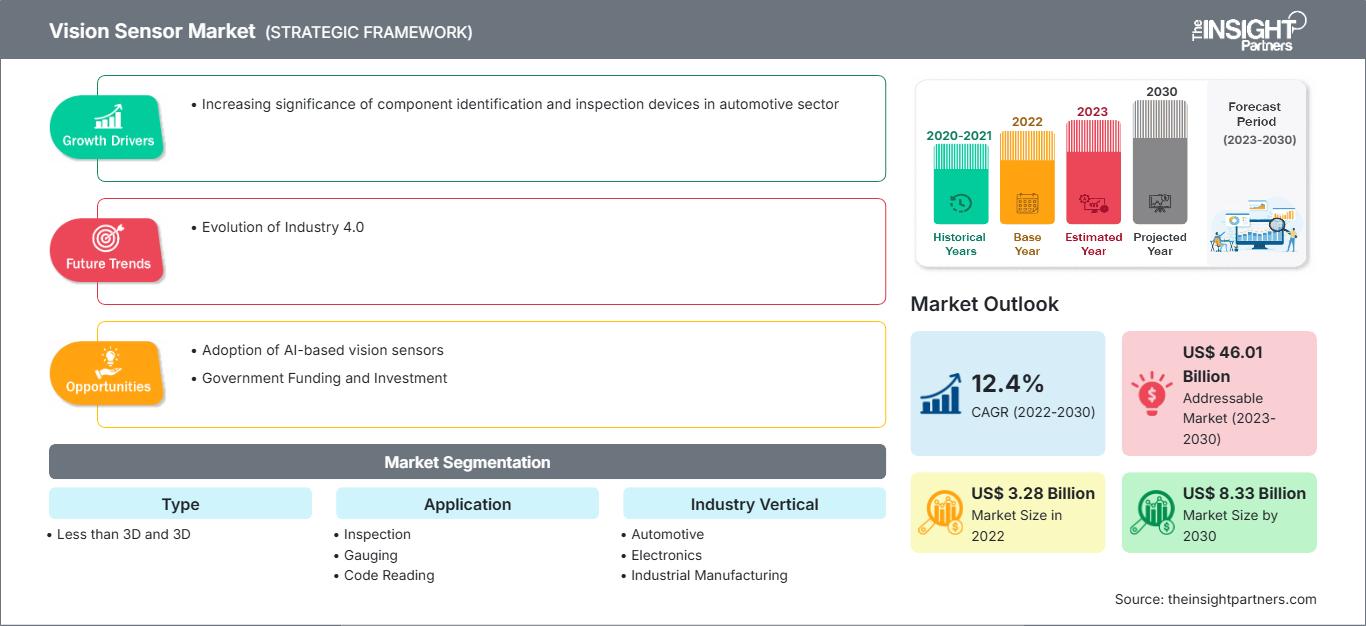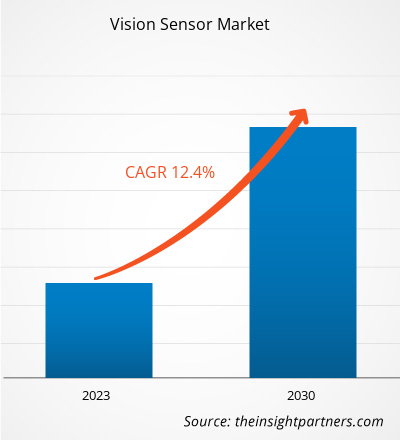Der Markt für Bildverarbeitungssensoren soll von 3,28 Milliarden US-Dollar im Jahr 2022 auf 8,33 Milliarden US-Dollar im Jahr 2030 anwachsen. Für den Markt wird von 2022 bis 2030 eine durchschnittliche jährliche Wachstumsrate (CAGR) von 12,4 % erwartet. Die Entwicklung von Industrie 4.0 wird voraussichtlich ein wichtiger Markttrend für Bildverarbeitungssensoren bleiben.
Marktanalyse für Bildverarbeitungssensoren
Das Wachstum des Marktes für Bildverarbeitungssensoren wird durch die steigende Nachfrage nach Automobilen, Elektronik und Robotik, steigende Investitionen in Forschung und Entwicklung sowie die zunehmende Nutzung von Cloud-Technologien vorangetrieben. Die Entwicklung von Industrie 4.0 und staatliche Investitionen in die industrielle Automatisierung werden dem Marktwachstum im Prognosezeitraum voraussichtlich zusätzlichen Schwung verleihen. Darüber hinaus treibt die Expansion der Elektro- und Elektronikindustrie das Marktwachstum voran. Die hohen Kosten für Installation und Wartung von 3D-Bildverarbeitungssensoren behindern jedoch das Marktwachstum. Der technologische Fortschritt und die Entwicklung KI-basierter Bildsensoren schaffen lukrative Marktchancen.
Marktübersicht für Bildsensoren
Ein Bildsensor ist ein in eine Kamera oder ein Bildgebungssystem integriertes Gerät zur Erfassung visueller Informationen. Bildsensoren nutzen von einer Kamera erfasste Bilder oder visuelle Daten, um die Ausrichtung, Anwesenheit und Genauigkeit von Teilen zu bestimmen. Diese Sensoren vereinfachen Konstruktion und Betrieb durch die Kombination von Kamera, Licht und Controller in einer einzigen Einheit. Bildsensoren werden hauptsächlich zur Erkennung defekter Objekte, zur Zeichenerkennung, zum Sortieren von Objekten und zur Größenmessung von Objekten eingesetzt. Ein Netzwerk von Bildsensoren lässt sich problemlos mit Werks- und Unternehmensnetzwerken verbinden, sodass Fabriken Bilder, Ergebnisse und Daten zur Prozesssteuerung einsehen können. Bildsensoren bieten erhebliche Vorteile wie die schnelle Integration in größere Systeme, integrierte Ethernet-Kommunikation, die Notwendigkeit einer Programmierung und den Datenaustausch mit anderen Systemen zur Ergebnisübermittlung durch Auslösen nachfolgender Prüfschritte.
Passen Sie diesen Bericht Ihren Anforderungen an
Sie erhalten kostenlos Anpassungen an jedem Bericht, einschließlich Teilen dieses Berichts oder einer Analyse auf Länderebene, eines Excel-Datenpakets sowie tolle Angebote und Rabatte für Start-ups und Universitäten.
Markt für Vision-Sensoren: Strategische Einblicke

-
Holen Sie sich die wichtigsten Markttrends aus diesem Bericht.Dieses KOSTENLOSE Beispiel umfasst Datenanalysen, die von Markttrends bis hin zu Schätzungen und Prognosen reichen.
Treiber und Chancen des Vision-Sensor-Marktes
Die zunehmende Bedeutung von Geräten zur Komponentenidentifizierung und -prüfung in der Automobilindustrie treibt den Vision-Sensor-Markt an
Vision-Sensoren helfen Fahrern, Fußgänger, andere Autos und Hindernisse zu erkennen, indem sie sie warnen, das Fahrzeug zu verlangsamen oder schnell anzuhalten. Das Wachstum der Automobilindustrie in Verbindung mit steigenden Investitionen beflügelt den Vision-Sensor-Markt. Laut dem Industrial R&D Investment Scoreboard Edition 2023 der Europäischen Union (EU) liegt die EU weiterhin mit 42,2 % weltweit an der Spitze der F&E-Investitionen im Automobilbereich, gefolgt von Japan und den USA mit jeweils 19,5 % und China mit 12,8 % im letzten Jahrzehnt. Wachsende Investitionen in F&E ermutigen Hersteller, fortschrittliche Lösungen für ihre Kunden zu entwickeln, was den Vision-Sensor-Markt ankurbelt. Einige wichtige Anwendungen, die die Nachfrage nach Bildverarbeitungssensoren in der Automobilindustrie erhöhen, sind die Prüfung verschiedener Teile und Komponenten, die Identifizierung fehlerhafter Teile und falsch ausgerichteter Teile und Komponenten sowie die Führung von Roboterarmen zur Durchführung komplexer Aufgaben am Fließband.
Segmentierungsanalyse des Marktberichts zur Bildverarbeitungssensorik
Schlüsselsegmente, die zur Ableitung der Marktanalyse für Bildverarbeitungssensoren beigetragen haben, sind Typ, Anwendung und Branche.
- Basierend auf dem Typ ist der Markt für Bildverarbeitungssensoren in weniger als 3D und 3D unterteilt. Das 3D-Segment wird im Prognosezeitraum voraussichtlich wachsen.
- Das Segment der 3D-Bildverarbeitungssensoren wird im Prognosezeitraum aufgrund der hohen Nachfrage aus der Automobilindustrie voraussichtlich mit einer höheren CAGR wachsen.
- 3D-Bildverarbeitungssensoren sind hocheffektiv bei Anwendungen zur Fehlererkennung und Qualitätsprüfung, was ihre Verwendung in Automobil-Fließbändern fördert. 3D-Bildverarbeitungssensoren erfassen effektiv detaillierte 3D-Informationen über Objekte und ermöglichen so präzise Messungen, Fehleridentifizierung und Oberflächenprüfung. Sie werden häufig in Bereichen eingesetzt, in denen hohe Qualitätsstandards entscheidend sind.
- 3D-Vision-Sensoren werden auch zur Dimensionsmessung eingesetzt, um die ordnungsgemäße Montage von Automobilkomponenten sicherzustellen, was die Akzeptanz bei Automobilherstellern erhöht.
Analyse der Marktanteile von Vision-Sensoren nach Geografie
Der geografische Umfang des Berichts zum Markt für Vision-Sensoren ist hauptsächlich in fünf Regionen unterteilt: Nordamerika, Asien-Pazifik, Europa, Naher Osten und Afrika sowie Südamerika/Süd- und Mittelamerika.
Europa wird im Prognosezeitraum voraussichtlich stark wachsen. Der europäische Markt für Vision-Sensoren ist in Deutschland, Frankreich, Großbritannien, Italien, Russland und das übrige Europa segmentiert. Die Region trägt aufgrund der hohen Akzeptanz und Investitionen in Vision-Sensoren in der Region einen bemerkenswerten Anteil zum globalen Markt für Vision-Sensoren bei. Der zunehmende Einsatz intelligenter Vision-Sensoren in verschiedenen Branchen treibt den Markt in der Region an. Beispielsweise hat der italienische Hersteller Datasensing im Juli 2023 seine Smart-VS-Serie (Vision-Sensor) erweitert, um die Erkennungsleistung zu verbessern. Das Unternehmen hat den Smart-VS+ eingeführt, um zahlreiche Branchen zu unterstützen, darunter die Automobilindustrie, die industrielle Fertigung, die Lebensmittel- und Getränkeindustrie, die Pharmaindustrie, die Verpackungsindustrie, die Kosmetikindustrie und die allgemeine Fertigung. Smart-VS+ bietet dem Anwender erhebliche Vorteile, wie beispielsweise die Erhöhung der Gesamtzahl der Lerndatensatzbilder auf bis zu 20 sowie die Verbesserung der Genauigkeit und Geschwindigkeit der Objekterkennung. Die intelligenten Bildsensoren werden auch eingesetzt, um das Vorhandensein/Fehlen und die korrekte Ausrichtung verschiedener Objekte, einschließlich Etiketten, Aufdrucken und Verschlüssen, unabhängig von Material, Größe, Format und Farbe zu überprüfen. Der erhebliche Nutzen intelligenter Bildsensoren und steigende Investitionen in Forschung und Entwicklung zählen zu den weiteren Faktoren, die den Markt in der Region antreiben.
Bildsensor
Regionale Einblicke in den Markt für Vision-Sensoren
Die Analysten von The Insight Partners haben die regionalen Trends und Faktoren, die den Markt für Vision-Sensoren im Prognosezeitraum beeinflussen, ausführlich erläutert. In diesem Abschnitt werden auch die Marktsegmente und die geografische Lage in Nordamerika, Europa, dem asiatisch-pazifischen Raum, dem Nahen Osten und Afrika sowie Süd- und Mittelamerika erörtert.
Umfang des Marktberichts zum Vision-Sensor
| Berichtsattribut | Einzelheiten |
|---|---|
| Marktgröße in 2022 | US$ 3.28 Billion |
| Marktgröße nach 2030 | US$ 8.33 Billion |
| Globale CAGR (2022 - 2030) | 12.4% |
| Historische Daten | 2020-2021 |
| Prognosezeitraum | 2023-2030 |
| Abgedeckte Segmente |
By Typ
|
| Abgedeckte Regionen und Länder |
Nordamerika
|
| Marktführer und wichtige Unternehmensprofile |
|
Dichte der Marktteilnehmer für Vision-Sensoren: Auswirkungen auf die Geschäftsdynamik verstehen
Der Markt für Vision-Sensoren wächst rasant. Die steigende Nachfrage der Endverbraucher ist auf Faktoren wie veränderte Verbraucherpräferenzen, technologische Fortschritte und ein stärkeres Bewusstsein für die Produktvorteile zurückzuführen. Mit der steigenden Nachfrage erweitern Unternehmen ihr Angebot, entwickeln Innovationen, um den Bedürfnissen der Verbraucher gerecht zu werden, und nutzen neue Trends, was das Marktwachstum weiter ankurbelt.

- Holen Sie sich die Markt für Vision-Sensoren Übersicht der wichtigsten Akteure
Marktneuigkeiten und aktuelle Entwicklungen im Bereich Vision-Sensoren
Der Markt für Vision-Sensoren wird durch die Erhebung qualitativer und quantitativer Daten aus Primär- und Sekundärforschung bewertet, die wichtige Unternehmenspublikationen, Verbandsdaten und Datenbanken umfasst. Im Folgenden finden Sie eine Liste der Entwicklungen auf dem Markt für Vision-Sensoren und Strategien:
- Im September 2023 brachte die Cognex Corporation den In-Sight SnAPP Vision-Sensor auf den Markt, der Einfachheit und Genauigkeit bietet, indem er die Effizienz von Herstellungsprozessen schnell verbessert. Der In-Sight SnAPP Vision-Sensor erweiterte seine Kapazitäten und erwirtschaftete in den von ihm bedienten Märkten einen Umsatz von 1 Milliarde US-Dollar. (Quelle: Cognex Corporation, Pressemitteilung/Unternehmenswebsite/Newsletter, 2023)
- Im Oktober 2022 brachte die SensoPart Industriesensorik GmbH den VISOR UV auf den Markt, um für das menschliche Auge unsichtbare Markierungen, Codes und Beschriftungen zu bewerten. VISOR UV ist mit UV-Beleuchtung integriert und verfügt über zwei Auflösungen: V50: 2560 x 1936 Pixel und V20: 1440 x 1080 Pixel. (Quelle: SensoPart Industriesensorik GmbH, Pressemitteilung/Unternehmenswebsite/Newsletter, 2023)
Bericht zum Markt für Vision-Sensoren – Abdeckung und Ergebnisse
Der „Markt für Vision-Sensoren – Größe und Prognose (2022–2030)“ Der Bericht bietet eine detaillierte Analyse des Marktes und deckt die folgenden Bereiche ab:
- Marktgröße und -prognose auf globaler, regionaler und Länderebene für alle abgedeckten wichtigen Marktsegmente
- Marktdynamik wie Treiber, Beschränkungen und wichtige Chancen
- Wichtige zukünftige Trends
- Detaillierte PEST/Porters Five Forces- und SWOT-Analyse
- Globale und regionale Marktanalyse mit wichtigen Markttrends, wichtigen Akteuren, Vorschriften und aktuellen Marktentwicklungen
- Branchenlandschaft und Wettbewerbsanalyse mit Marktkonzentration, Heatmap-Analyse, prominenten Akteuren und aktuellen Entwicklungen
- Detaillierte Unternehmensprofile
- Historische Analyse (2 Jahre), Basisjahr, Prognose (7 Jahre) mit CAGR
- PEST- und SWOT-Analyse
- Marktgröße Wert/Volumen – Global, Regional, Land
- Branchen- und Wettbewerbslandschaft
- Excel-Datensatz
Aktuelle Berichte
Verwandte Berichte
Erfahrungsberichte
Grund zum Kauf
- Fundierte Entscheidungsfindung
- Marktdynamik verstehen
- Wettbewerbsanalyse
- Kundeneinblicke
- Marktprognosen
- Risikominimierung
- Strategische Planung
- Investitionsbegründung
- Identifizierung neuer Märkte
- Verbesserung von Marketingstrategien
- Steigerung der Betriebseffizienz
- Anpassung an regulatorische Trends






















 Kostenlose Probe anfordern für - Markt für Vision-Sensoren
Kostenlose Probe anfordern für - Markt für Vision-Sensoren